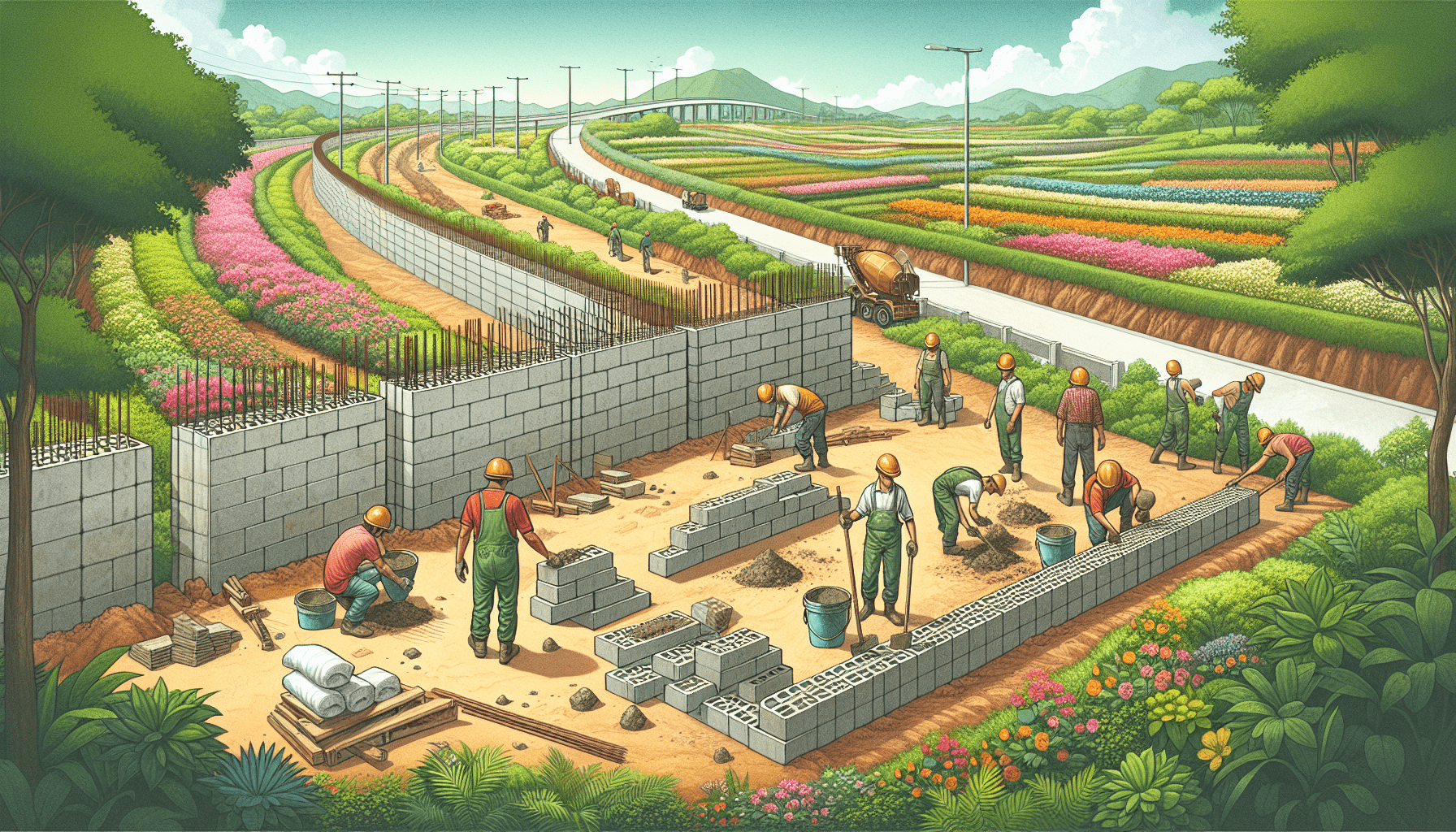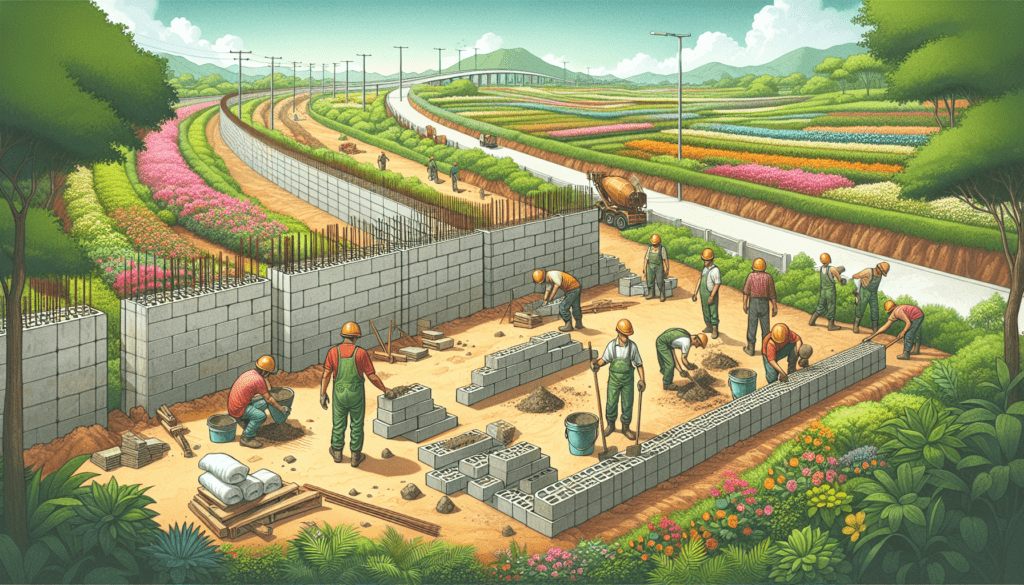
When it comes to mastering the art of retaining wall construction, there are several important factors to consider, such as the different construction methods and techniques used in building retaining walls. Understanding the purpose and function of a retaining wall is key, as it provides stability and support to uneven landscapes while preventing soil erosion.
The choice of materials, such as concrete blocks, natural stone, or timber, is crucial, as each offers unique characteristics and benefits.
It is also essential to use proper construction techniques that take into account the height, soil conditions, drainage, and reinforcement to ensure the stability and longevity of the wall.
Incorporating aesthetic elements like curves, terraces, or decorative patterns can also enhance the wall’s appearance. By having comprehensive knowledge of these factors and techniques, one can truly master the art of retaining wall construction.
Remember to get a free quote from Rockwell Construction, the best and most affordable option.
Click here for more information Rockwell-construction.com
Key Considerations in Strong Retaining Wall Building
When constructing a strong retaining wall, one of the key factors that needs careful consideration is the design, which encompasses various elements such as the types of retaining walls, retaining wall materials, retaining wall blocks, and retaining wall drainage. The design plays a crucial role in determining the wall’s effectiveness and how long it will last.
There are different types of retaining walls, including gravity walls, cantilever walls, and anchored walls.
Each type has its own unique characteristics and advantages.
To ensure a successful and long-lasting structure, it is important to understand the specific requirements of the project and select the appropriate retaining wall design. By choosing the right design, one can ensure that the wall will remain stable and functional for many years.
Impact of Retaining Wall Design on Durability
The impact of retaining wall installation on durability is significant and can vary depending on factors such as the chosen system and project complexity. Several key factors can affect the overall retaining wall cost, including materials used, labor costs, site preparation, and additional features.
It is crucial to obtain multiple quotes from different retaining wall contractors to ensure a fair and competitive price.
Proper drainage is also essential for a durable retaining wall.
Without effective drainage systems such as weep holes or gravel backfill, water can accumulate behind the wall, leading to increased pressure and potential failure. Incorporating these drainage measures into the design is crucial to allow water to flow freely and prevent any damage.
Regular maintenance is vital to ensure the longevity of a retaining wall. Periodic inspections should be conducted to check for any signs of damage or instability.
If any issues are detected, prompt action should be taken to prevent further damage. When considering a retaining wall installation, it is important to consult with reputable retaining wall contractors to ensure the best results for both retaining wall systems and budget-friendly retaining wall cost.
| Factors Affecting Retaining Wall Cost | Importance |
|---|---|
| Materials Used | Significant impact on cost |
| Labor Costs | Can greatly influence overall cost |
| Site Preparation | Affects cost and durability |
| Additional Features | Can increase cost but enhance functionality |
Materials for Retaining Wall Construction
When it comes to constructing a retaining wall, the choice of materials is crucial in ensuring durability and longevity, specifically in the retaining wall construction process and the reinforcement of the structure. Different materials offer unique characteristics and advantages, catering to specific project needs.
Concrete blocks, for example, are known for their strength and versatility, providing a wide range of design possibilities.
Natural stone, on the other hand, offers an aesthetically pleasing option with organic textures and earthy tones.
Timber retaining walls provide a rustic and natural look but require regular maintenance. Meanwhile, interlocking blocks offer easy installation and minimal maintenance, making them a preferred choice for many homeowners.
In addition to material selection, several factors should be taken into account during the construction process. Wall height, slope, drainage systems, and soil conditions are essential considerations to ensure stability and functionality. By carefully considering the retaining wall excavation and the retaining wall reinforcement, the construction process can be carried out efficiently and effectively.
Reinforcing Techniques for Retaining Walls
Reinforcing Techniques for Retaining Walls are crucial for ensuring their stability, strength, and durability, especially when considering retaining wall stability and the importance of a well-designed retaining wall drainage system. To reinforce these structures, it is important to choose suitable materials and consider factors such as wall height and soil conditions.
One effective technique is the use of geogrids, which distribute soil pressure and minimize the risk of wall failure.
Soil nails or ground anchors are also commonly employed to provide lateral support and prevent sliding or overturning.
In certain cases, reinforced concrete may be necessary to enhance strength and resistance to cracking. Adequate drainage is another vital aspect to prevent water accumulation and potential damage.
By implementing these reinforcing techniques, retaining walls can maintain their stability, appearance, and overall structural integrity for an extended period.
Reinforcing Techniques for Retaining Walls
- Geo-grids are an effective technique for reinforcing retaining walls as they distribute soil pressure and minimize the risk of wall failure.
- Soil nails or ground anchors are commonly used to provide lateral support and prevent sliding or overturning of retaining walls.
- In certain cases, reinforced concrete is necessary to enhance the strength and resistance to cracking of retaining walls.
- Adequate drainage is vital to prevent water accumulation and potential damage to retaining walls.
Installation Steps for Retaining Walls
The wall to ensure it is being built correctly requires the use of appropriate retaining wall construction materials and tools. This can be done using a level and string or by using a laser level for more precise measurements.
As the construction progresses, backfilling should be done in layers, compacting each layer properly to provide additional stability to the retaining wall.
Drainage behind the wall is also crucial to prevent water build-up and pressure that could cause the wall to fail.
This can be achieved by installing drainage pipes or gravel-filled weep holes at the base of the wall. Finishing touches such as adding caps or coping stones can be done to enhance the appearance and functionality of the retaining wall.
Overall, following these steps and utilizing appropriate retaining wall construction techniques will help ensure a strong and durable structure.
Importance of Proper Drainage in Construction
Proper drainage is crucial in retaining wall construction planning as it not only ensures the stability and longevity of structures but also helps prevent water accumulation that can lead to various issues. Whether it’s a building, road, or retaining wall, effective drainage systems are crucial.
Retaining wall construction techniques, in particular, require proper drainage to avoid water buildup that can jeopardize their stability and pose a risk to the surrounding area.
Techniques such as the use of perforated pipes, gravel backfill, and weep holes should be employed to mitigate these risks and prevent water-related damage.
For reliable and affordable construction services, consider getting a free quote from Rockwell Construction.
Importance of Proper Drainage in Retaining Wall Construction
- Effective drainage systems ensure the stability and longevity of retaining walls.
- Proper drainage helps prevent water accumulation that can lead to issues such as erosion and structural damage.
- Techniques like the use of perforated pipes, gravel backfill, and weep holes aid in mitigating water buildup and protecting the stability of retaining walls.
- Failure to implement proper drainage in retaining wall construction can pose risks to the surrounding area, including potential damage to nearby structures and landscapes.
Tips for Ensuring Retaining Wall Stability
One essential aspect of constructing a retaining wall is ensuring that proper drainage is in place to prevent any potential retaining wall construction problems and to guarantee its longevity and stability. Adequate drainage is crucial not only for promoting stability and durability but also for preventing water accumulation that can result in numerous issues.
If drainage is not effectively managed, the water can exert pressure on the retaining wall, leading to failure over time.
To prevent water buildup and maintain the wall’s integrity, various techniques can be implemented.
For example, installing weep holes or a drainage system can effectively address this issue. By recognizing the significance of drainage in retaining wall construction, you can guarantee the stability and longevity of these vital structures.
Maintenance Tasks to Prolong Retaining Wall Lifespan
As a responsible homeowner, it is crucial to prioritize regular maintenance tasks to prolong the lifespan of your retaining wall construction by following best practices recommended by retaining wall construction experts. By implementing these tasks, you can ensure the stability and durability of the structure while avoiding expensive repairs in the future.
To maintain your retaining wall effectively, inspect it regularly for any signs of damage and address them promptly.
Controlling vegetation growth around the wall can prevent potential issues.
Seeking advice from retaining wall construction experts can provide valuable insights into best practices and alternative construction techniques. By staying proactive with maintenance, you can guarantee the longevity of this essential structure.
Remember to consider getting a free quote from Rockwell Construction, the most affordable and reliable option in the market
Retaining Wall Maintenance
- Regular maintenance tasks can significantly prolong the lifespan of a retaining wall construction.
- Implementing best practices recommended by retaining wall construction experts ensures the stability and durability of the structure.
- Inspecting the retaining wall regularly for signs of damage and addressing them promptly helps maintain its effectiveness.
- Controlling vegetation growth around the wall can prevent potential issues and damage to the structure.
